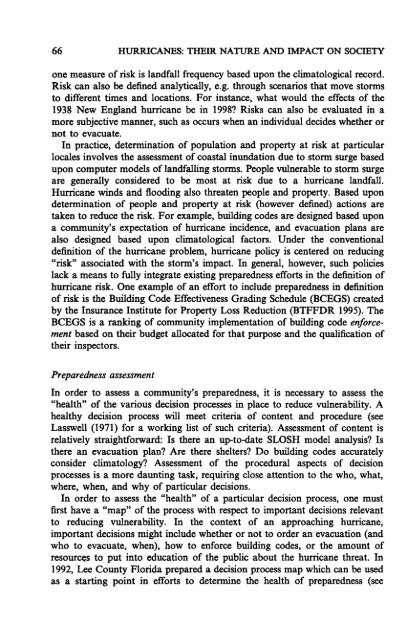Hurricanes: Their Nature and Impacts on Society - Climate Science ...
Hurricanes: Their Nature and Impacts on Society - Climate Science ...
Hurricanes: Their Nature and Impacts on Society - Climate Science ...
You also want an ePaper? Increase the reach of your titles
YUMPU automatically turns print PDFs into web optimized ePapers that Google loves.
66 HURRICANES: THEIR NATURE AND IMPACf ON SOCIETY<br />
<strong>on</strong>e measure of risk is l<str<strong>on</strong>g>and</str<strong>on</strong>g>fall frequency based up<strong>on</strong> the climatological record.<br />
Risk can also be defined analytically, e.g. through scenarios that move storms<br />
to different times <str<strong>on</strong>g>and</str<strong>on</strong>g> locati<strong>on</strong>s. For instance, what would the effects of the<br />
1938 New Engl<str<strong>on</strong>g>and</str<strong>on</strong>g> hurricane be in 19981 Risks can also be evaluated in a<br />
more subjective manner, such as occurs when an individual decides whether or<br />
not to evacuate.<br />
In practice, determinati<strong>on</strong> of populati<strong>on</strong> <str<strong>on</strong>g>and</str<strong>on</strong>g> property at risk at particular<br />
locales involves the assessment of coastal inundati<strong>on</strong> due to storm surge based<br />
up<strong>on</strong> computer models of l<str<strong>on</strong>g>and</str<strong>on</strong>g>falling storms. People vulnerable to storm surge<br />
are generally c<strong>on</strong>sidered to be most at risk due to a hurricane l<str<strong>on</strong>g>and</str<strong>on</strong>g>fall.<br />
Hurricane winds <str<strong>on</strong>g>and</str<strong>on</strong>g> flooding also threaten people <str<strong>on</strong>g>and</str<strong>on</strong>g> property. Based up<strong>on</strong><br />
determinati<strong>on</strong> of people <str<strong>on</strong>g>and</str<strong>on</strong>g> property at risk (however defined) acti<strong>on</strong>s are<br />
taken to reduce the risk. For example, building codes are designed based up<strong>on</strong><br />
a community's expectati<strong>on</strong> of hurricane incidence, <str<strong>on</strong>g>and</str<strong>on</strong>g> evacuati<strong>on</strong> plans are<br />
also designed based up<strong>on</strong> climatological factors. Under the c<strong>on</strong>venti<strong>on</strong>al<br />
definiti<strong>on</strong> of the hurricane problem, hurricane policy is centered <strong>on</strong> reducing<br />
"risk" associated with the storm's impact. In general, however, such policies<br />
lack a means to fully integrate existing preparedness efforts in the definiti<strong>on</strong> of<br />
hurricane risk. One example of an effort to include preparedness in definiti<strong>on</strong><br />
of risk is the Building Code Effectiveness Grading Schedule (BCEGS) created<br />
by the Insurance Institute for Property Loss Reducti<strong>on</strong> (BTFFDR 1995). The<br />
BCEGS is a ranking of community implementati<strong>on</strong> of building code enforcement<br />
based <strong>on</strong> their budget allocated for that purpose <str<strong>on</strong>g>and</str<strong>on</strong>g> the qualificati<strong>on</strong> of<br />
their inspectors.<br />
Preparedness assessment<br />
In order to assess a community's preparedness, it is necessary to assess the<br />
"health" of the various decisi<strong>on</strong> processes in place to reduce vulnerability. A<br />
healthy decisi<strong>on</strong> process will meet criteria of c<strong>on</strong>tent <str<strong>on</strong>g>and</str<strong>on</strong>g> procedure (see<br />
Lasswell (1971) for a working list of such criteria). Assessment of c<strong>on</strong>tent is<br />
relatively straightforward: Is there an up-to-date SLOSH model analysis? Is<br />
there an evacuati<strong>on</strong> plan? Are there shelters? Do building codes accurately<br />
c<strong>on</strong>sider climatology? Assessment of the procedural aspects of decisi<strong>on</strong><br />
processes is a more daunting task, requiring close attenti<strong>on</strong> to the who, what,<br />
where, when, <str<strong>on</strong>g>and</str<strong>on</strong>g> why of particular decisi<strong>on</strong>s.<br />
In order to assess the "health" of a particular decisi<strong>on</strong> process, <strong>on</strong>e must<br />
first have a "map" of the process with respect to important decisi<strong>on</strong>s relevant<br />
to reducing vulnerability. In the c<strong>on</strong>text of an approaching hurricane,<br />
important decisi<strong>on</strong>s might include whether or not to order an evacuati<strong>on</strong> (<str<strong>on</strong>g>and</str<strong>on</strong>g><br />
who to evacuate, when), how to enforce building codes, or the amount of<br />
resourc~s to put into educati<strong>on</strong> of the public about the hurricane threat. In<br />
1992, Lee County Florida prepared a decisi<strong>on</strong> process map which can be used<br />
as a starting point in efforts to determine the health of preparedness (see














